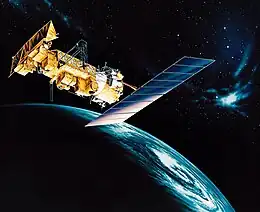| Mission type | Weather |
|---|---|
| Operator | NOAA |
| COSPAR ID | 1974-106A[1] |
| SATCAT no. | 4793 |
| Spacecraft properties | |
| Manufacturer | RCA Astro |
| Launch mass | 306 kilograms (675 lb) |
| Start of mission | |
| Launch date | December 11, 1970, 11:35 UTC[2] |
| Rocket | Delta-N6 |
| Launch site | Vandenberg SLC-2W |
| End of mission | |
| Deactivated | August 19, 1971 |
| Orbital parameters | |
| Reference system | Geocentric |
| Regime | Sun-synchronous |
| Eccentricity | 0.00319 |
| Perigee altitude | 1,422 kilometers (884 mi) |
| Apogee altitude | 1,472 kilometers (915 mi) |
| Inclination | 101.9 degrees |
| Period | 114.8 minutes |
| Epoch | December 11, 1970 |
| Instruments | |
| APT, AVCS, FPR, SPME, SR | |
ITOS | |
NOAA-1, also known as ITOS-A was a weather satellite operated by the National Oceanic and Atmospheric Administration (NOAA). It was part of a series of satellites called ITOS, or improved TIROS.[3] NOAA-1 was launched on a Delta rocket on December 11, 1970. The launch carried one other satellite: CEP 1.[2] It was deactivated by NOAA on August 19, 1971.
References
- ↑ "NASA/NSSDC NOAA-1 spacecraft details". Retrieved June 7, 2018.
- 1 2 McDowell, Jonathan. "Launch Log". Jonathan's Space Page. Retrieved June 6, 2018.
- ↑ Wade, Mark. "ITOS". Encyclopedia Astronautica. Archived from the original on June 21, 2002. Retrieved June 7, 2018.
External links
This article is issued from Wikipedia. The text is licensed under Creative Commons - Attribution - Sharealike. Additional terms may apply for the media files.
